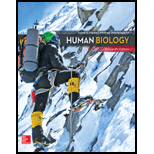
Human Biology
16th Edition
ISBN: 9781260482799
Author: Mader, Sylvia
Publisher: MCGRAW-HILL HIGHER EDUCATION
expand_more
expand_more
format_list_bulleted
Concept explainers
Question
Chapter 25.2, Problem 4CYP
Summary Introduction
To analyze:
Consequences of using fossil fuels as an energy source.
Introduction:
Fossil fuels are the carbon rich material which form over the million years when deposited plants and animal remains beneath layer of sediments exposed to extreme heat and pressure.
Fossil fuels are non-renewable energy source, which can be extracted from the different layers of sediments.
Expert Solution & Answer
Want to see the full answer?
Check out a sample textbook solution
Students have asked these similar questions
What are the structure and properties of atoms and chemical bonds (especially how they relate to DNA and proteins).
The Sentinel Cell: Nature’s Answer to Cancer?
Molecular Biology Question
You are working to characterize a novel protein in mice. Analysis shows that high levels of the primary transcript that codes for this protein are found in tissue from the brain, muscle, liver, and pancreas. However, an antibody that recognizes the C-terminal portion of the protein indicates that the protein is present in brain, muscle, and liver, but not in the pancreas. What is the most likely explanation for this result?
Chapter 25 Solutions
Human Biology
Ch. 25.1 - Define the terms exponential growth and carrying...Ch. 25.1 - Prob. 2LOCh. 25.1 - Compare and contrast the difference between...Ch. 25.1 - Calculate the annual growth rate of a population...Ch. 25.1 - Compare the characteristics of an MDC with those...Ch. 25.1 - Prob. 3CYPCh. 25.2 - Prob. 1LOCh. 25.2 - Prob. 2LOCh. 25.2 - Prob. 3LOCh. 25.2 - List the five main classes of resources.
Ch. 25.2 - Describe how humans have increased the...Ch. 25.2 - Prob. 3CYPCh. 25.2 - Prob. 4CYPCh. 25.2 - Prob. 5CYPCh. 25.3 - Prob. 1LOCh. 25.3 - Prob. 2LOCh. 25.3 - Prob. 3LOCh. 25.3 - Prob. 1.1BTSCh. 25.3 - What other species might be suffering similar...Ch. 25.3 - Prob. 2.1BTSCh. 25.3 - Prob. 2.2BTSCh. 25.3 - Prob. 1CYPCh. 25.3 - Prob. 2CYPCh. 25.3 - Prob. 3CYPCh. 25.4 - Prob. 1LOCh. 25.4 - Prob. 2LOCh. 25.4 - Prob. 3LOCh. 25.4 - Describe the characteristics of todays society...Ch. 25.4 - Prob. 2CYPCh. 25.4 - Summarize how scientists assess economic...Ch. 25 - Prob. 1ACh. 25 - Prob. 2ACh. 25 - Prob. 3ACh. 25 - Prob. 4ACh. 25 - Prob. 5ACh. 25 - Prob. 6ACh. 25 - Prob. 7ACh. 25 - Prob. 8ACh. 25 - Prob. 9ACh. 25 - Prob. 10ACh. 25 - Prob. 1TCCh. 25 - Prob. 2TCCh. 25 - a. What types of environmental activities or...
Knowledge Booster
Learn more about
Need a deep-dive on the concept behind this application? Look no further. Learn more about this topic, biology and related others by exploring similar questions and additional content below.Similar questions
- Molecular Biology Explain/discuss how “slow stop” and “quick/fast stop” mutants wereused to identify different protein involved in DNA replication in E. coli.arrow_forwardMolecular Biology Question A gene that codes for a protein was removed from a eukaryotic cell and inserted into a prokaryotic cell. Although the gene was successfully transcribed and translated, it produced a different protein than it produced in the eukaryotic cell. What is the most likely explanation?arrow_forwardMolecular Biology LIST three characteristics of origins of replicationarrow_forward
- Molecular Biology Question Please help. Thank you For E coli DNA polymerase III, give the structure and function of the b-clamp sub-complex. Describe how the structure of this sub-complex is important for it’s function.arrow_forwardMolecular Biology LIST three characteristics of DNA Polymerasesarrow_forwardMolecular Biology RNA polymerase core enzyme structure contains what subunits? To form holo enzyme, sigma factor is added to core. What is the name of the structure formed? Give the detailed structure of sigma factor and the function of eachdomain. Please help. Thank youarrow_forward
- Molecular Biology You have a single bacterial cell whose DNA is labelled with radioactiveC14. After 5 rounds of cell division, how may cells will contain radioactive DNA? Please help. Thank youarrow_forward1. Explain the structure and properties of atoms and chemical bonds (especially how they relate to DNA and proteins). Also add some pictures.arrow_forward1. In the Sentinel Cell DNA integrity is preserved through nanoscopic helicase-coordinated repair, while lipids in the membrane are fortified to resist environmental mutagens. also provide pictures for this question.arrow_forward
- Explain the structure and properties of atoms and chemical bonds (especially how they relate to DNA and proteins). Also add some pictures.arrow_forwardIn the Sentinel Cell DNA integrity is preserved through nanoscopic helicase-coordinated repair, while lipids in the membrane are fortified to resist environmental mutagens. also provide pictures for this question.arrow_forward1. Explain how genetic information is stored, copied, transferred, and expressed. Also add some pictures for this question.arrow_forward
arrow_back_ios
SEE MORE QUESTIONS
arrow_forward_ios
Recommended textbooks for you
 Human Biology (MindTap Course List)BiologyISBN:9781305112100Author:Cecie Starr, Beverly McMillanPublisher:Cengage Learning
Human Biology (MindTap Course List)BiologyISBN:9781305112100Author:Cecie Starr, Beverly McMillanPublisher:Cengage Learning Concepts of BiologyBiologyISBN:9781938168116Author:Samantha Fowler, Rebecca Roush, James WisePublisher:OpenStax College
Concepts of BiologyBiologyISBN:9781938168116Author:Samantha Fowler, Rebecca Roush, James WisePublisher:OpenStax College
 Biology 2eBiologyISBN:9781947172517Author:Matthew Douglas, Jung Choi, Mary Ann ClarkPublisher:OpenStax
Biology 2eBiologyISBN:9781947172517Author:Matthew Douglas, Jung Choi, Mary Ann ClarkPublisher:OpenStax Comprehensive Medical Assisting: Administrative a...NursingISBN:9781305964792Author:Wilburta Q. Lindh, Carol D. Tamparo, Barbara M. Dahl, Julie Morris, Cindy CorreaPublisher:Cengage Learning
Comprehensive Medical Assisting: Administrative a...NursingISBN:9781305964792Author:Wilburta Q. Lindh, Carol D. Tamparo, Barbara M. Dahl, Julie Morris, Cindy CorreaPublisher:Cengage Learning

Human Biology (MindTap Course List)
Biology
ISBN:9781305112100
Author:Cecie Starr, Beverly McMillan
Publisher:Cengage Learning


Concepts of Biology
Biology
ISBN:9781938168116
Author:Samantha Fowler, Rebecca Roush, James Wise
Publisher:OpenStax College


Biology 2e
Biology
ISBN:9781947172517
Author:Matthew Douglas, Jung Choi, Mary Ann Clark
Publisher:OpenStax

Comprehensive Medical Assisting: Administrative a...
Nursing
ISBN:9781305964792
Author:Wilburta Q. Lindh, Carol D. Tamparo, Barbara M. Dahl, Julie Morris, Cindy Correa
Publisher:Cengage Learning
Microbial Nutrition and Growth; Author: Scientist Cindy;https://www.youtube.com/watch?v=rK3UkyWjkl8;License: Standard YouTube License, CC-BY